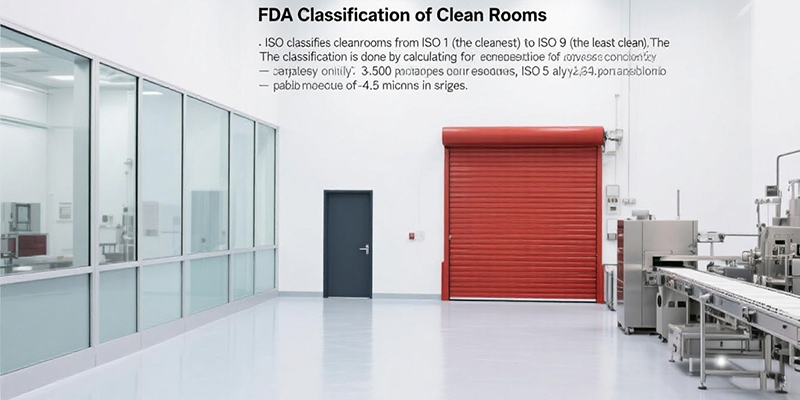Understanding FDA and ISO cleanroom classifications
Ensuring Product Safety and Compliance with Global Standards
Introduction
Cleanrooms are critical in industries like pharmaceuticals and medical devices to ensure product safety and compliance with stringent regulations. The FDA does not have its own unique cleanroom classification system but instead refers to the iso 14644-1 standards. This article explores how the FDA and ISO work in tandem and outlines the importance of these classifications for maintaining current Good Manufacturing Practice (cGMP).
ISO 14644-1 Standard
International Classification
The ISO 14644-1 standard provides a universal framework to classify cleanrooms based on the number of particles present in the air. This international standard is crucial for maintaining the environment's cleanliness in industries where contamination control is vital.
ISO Levels
ISO classifies cleanrooms from ISO 1 (the cleanest) to ISO 9 (the least clean). The classification is done by calculating the concentration of air particles. For example, iso 5 allows only 3,520 particles per cubic meter of 0.5 microns in size.
| ISO Class | Particles per m³ (≥0.5µm) | Typical Applications |
|---|---|---|
| ISO 1 | 10 | Ultra-sensitive semiconductor manufacturing |
| ISO 5 | 3,520 | Aseptic pharmaceutical processing, medical implants |
| ISO 7 | 352,000 | Non-sterile pharmaceutical preparation |
| iso 8 | 3,520,000 | Medical device packaging, food manufacturing |

FDA's Emphasis on GMP
cGMP Compliance
The FDA places significant emphasis on compliance with cGMP, which involves ongoing monitoring, validation, and maintaining specific cleanliness levels for manufacturing processes. Deiiang™, led by design expert Deiiang Jason.peng, provides state-of-the-art cleanroom solutions that help facilities comply with these rigorous standards.
Medical Devices
For medical devices, cleanroom classifications usually range from ISO 5 to ISO 8. Critical devices such as implants require purer environments, classified as ISO 5, whereas packaging operations might be acceptable in an ISO 8 environment.
Data Insight: 78% of Class III medical devices require iso 5 cleanrooms during manufacturing.
Pharmaceuticals
Pharmaceutical cleanrooms typically adhere to classifications ranging from ISO 5 to ISO 8, tailored to the sterility requirements of specific processes. For instance, aseptic processing often necessitates iso 5 environments to minimize contamination risks.
Data Insight: Aseptic filling operations show 60% fewer contaminants in ISO 5 vs. ISO 7 environments.
Food Manufacturing
To align with FDA standards, cleanrooms in food manufacturing generally need to meet at least ISO 6 requirements. These standards help ensure that the food products are free from contamination and safe for consumer consumption.
Data Insight: ISO 6 cleanrooms reduce microbial counts by 90% compared to conventional food processing areas.
Cleanroom Design: FDA and EU Classifications
While FDA regulations guide the U.S. market, EU classifications often have parallel standards ensuring consistency in global production. Deiiang™, with its expertise in cleanroom design, employs global best practices to satisfy both FDA and EU regulations, creating a seamless compliance framework.
| Parameter | FDA (US) | EU GMP |
|---|---|---|
| Primary Standard | References ISO 14644-1 | EU GMP Annex 1 |
| Aseptic Processing | ISO 5 (class 100) | Grade A |
| Monitoring Frequency | Continuous or as per risk assessment | Continuous for Grade A/B |
Common Questions and Answers
What is the main standard the FDA uses for cleanroom classification?
ISO 14644-1 is used for cleanroom classification based on air particle count.
Why is ISO 5 important in medical device manufacturing?
It ensures a highly controlled environment critical for sterile device production.
How do cGMP and ISO standards interact?
GMP compliance often involves adhering to specific ISO cleanliness standards to ensure product safety.
What ISO level is typically required for pharmaceutical sterile processing?
ISO 5 is commonly required for aseptic processing in pharmaceuticals.
Conclusion
Understanding the classifications of cleanrooms by both ISO and FDA standards is crucial for industries that rely on contamination control. The collaboration of these standards ensures that the products manufactured are safe, effective, and high quality. Deiiang™, through the innovation of Deiiang Jason.peng, continues to be a leader in providing compliant cleanroom solutions across industries.
 +86 18186671616
+86 18186671616 Jason@cleanroomequips.com
Jason@cleanroomequips.com
 MENU
MENU



